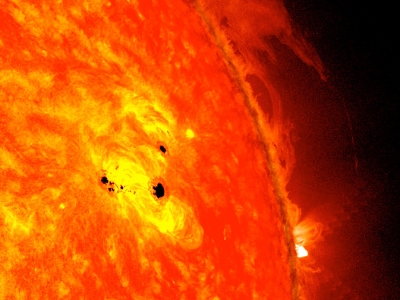What are sunspots of the Sun?

Sunspots are regions on the sun that appear dark. They occur in regions where the magnetic field of sun is strong. The temperature of a sunspot is super hot-something around 6,500 degrees Fahrenheit
The Sun, the centre of our solar system and our closest star, is 4.5 billion years old. This fiery glowing orb of hydrogen and helium sustains life as we know it
Sunspots
Sunspots are regions on the sun appear dark. These parts appear darker as they are cooler when compared to other parts of the sun. They occur in regions where the sun's magnetic field is highly concentrated or strong.
The centre of the sunspot is dark and this is called the umbra while the outer and lighter ring is called the penumbra. Spots vary in sizes. They could be larger than the Earth, or so tiny that it will be difficult to pick them up in telescopic observation. The sunspots could stay on for months. Most of the sunspots can be seen in pairs or groups but single spots also do occur. When they occur in pairs, they have opposite magnetic polarity.
Why are sunspots cooler
Sunspots form in areas on the sun where the magnetic field is very strong and powerful. These magnetic fields will prevent the heat within the Sun from reaching its surface. Even when we say that the sunspots are cooler, this is just in comparison to the other regions of the Sun. The temperature of a sunspot is super hot something around 6.500 degrees Fahrenheit.
Why do sunspots matter
In most cases, sunspots precede the occurrence of a solar flare. Solar flares are sudden bursts or explosions of energy from the sun's surface. This occurs when the magnetic field lines near the sunspots reorganise or cross. These solar flares will release huge amounts of radiation into space. The more intense the solar flare, the more intense will be its radiation. This can affect radio communication on Earth. Studying and monitoring the sunspots are required to understand the reason behind the occurrence of solar flares.
Picture Credit : Google